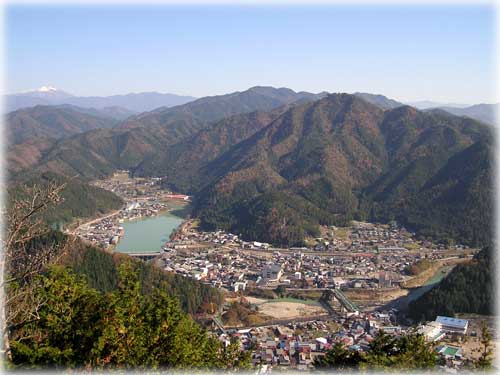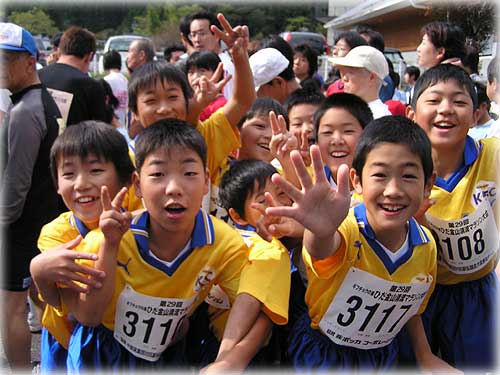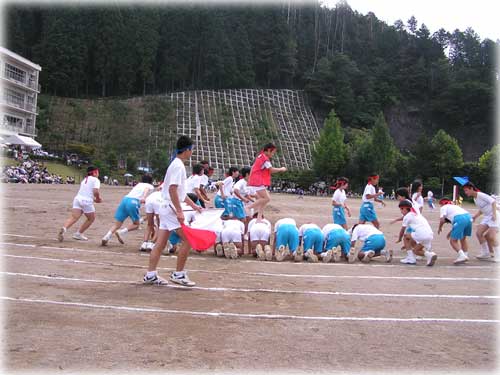 by Daniel Patton December 02, 2004
This is Dan Patton, the 2004-2005 Kanayama exchange English teacher, checking in from our beautiful sister city, Kanayama, Japan. Lately, the weather here has been absolutely gorgeous: crisp, cold nights give rise to a thick blanket of fog that by 9:00-10:00am has been burnt off by a bright sun, which in turn warms the air into the mid to upper 50's by noon. The fall colors peaked a few weeks ago in this part of Japan (the Japanese Maples and Gingko trees were absolutely radiant), but there in the lower lying areas there is still quite a bit of beautiful foliage to be seen. Like most good things, however, this weather won't last long and I'm constantly being reminded by the locals that winter is very cold in these parts. I try to explain that I spent my college years in interior Alaska and am accustomed to subzero temperatures, but they will have none of it. Fairbanks winters did have one distinct advantage over Japanese ones the tendency towards central heating in buildings. In Japan, central heating is the exception rather than the rule. There's a logical reason for this (it has to do with earthquake safe architecture), but regardless, Kanayama's cement-block schools have been feeling more like giant walk-in refrigerators lately! 
I was downright shocked when, at a Jr. High assembly on my first day back in early September, the students marched into the gym, sat down on the floor in perfectly straight rows, and proceeded to sit quietly and listen to a number of rather long and, seemingly, rather boring speeches (I, for one, understood nothing) given by the principal and other school officials. I tried to locate a student who was fidgeting, talking to his neighbor, or sleeping. It couldn't be done! The same occurred later at an Elementary school assembly. I wondered what path had led these kids to such outright compliance. I realize now it was a number of factors, many of which are certainly positive, other perhaps a bit negative, but all characteristically Japanese. First of all, from a very young age children are taught that school is a serious matter. Before each and every class, even in the very youngest of grades, the children all stand up and listen to a short speech, given by a different student each day. They usually sound something like: "Today we are going to study (...) . Let's work hard and do the best we can at learning (...)." Then they all give a quick bow and sit down. At the end of the class they do this again. "Today we studied (...) . Let's try the best we can to remember (...) ." And another quick bow. This is interesting because it offers the students a constant reminder of why they are there and also regular encouragement to try hard. Of course, it becomes a little superficial after being repeated so many times, but overall it seems to increase focus. Related to this is the tendency for the Japanese people to use the word "ganbate", which means 'do your best' or 'persevere'. It is an encouragement used in all kinds of situations from sports to work to cooking, but especially in the classroom. I often hear not only teachers, but students, telling other students to "ganbate". They seem genuinely concerned that their classmates do well. 
In Japan, as in much of the East, the importance of group harmony, as opposed to Western individualism, is deep rooted. This attitude is readily visible in the Japanese school system. The class is the basic unit, and anything that would bring shame to the class as a whole is looked down upon. This brings us back to that original school assembly. The students were seated together with their classmates. If a disturbance had been made, everyone would have immediately known from what class it came. The next group unit is the school itself. In order to foster a harmonious atmosphere, the students wear uniforms (Jr. High and above). This puts everyone on level ground. Even the sporting events are group oriented. At the annual 'Undokai' (Sports Festival) in September, I was surprised to see that there wasn't a single individual event, even the running races were relays. Many of the events depended a great deal on group cooperation. At a recent Elementary school exhibition, the third grade class did a skit in which they all rode unicycles. Teaching them all to ride the unicycles must have required a small act of God, but in Japan it would be no other way. I have noticed a lot of school pride among the students of Kanayama, and this emphasis on the group does a lot to explain where it comes from.  One event at the Kanayama Jr. High Undokai in late September...
Of course there's a lot more to say, but I'll save that for another column. In the mean time if you have any questions about Kanayama, Japan, or the exchange program please email me. Mata ne!
Dan Patton experiencealaska@yahoo.com
2004-2005 Exchange Teacher in Kanayama, Japan
|